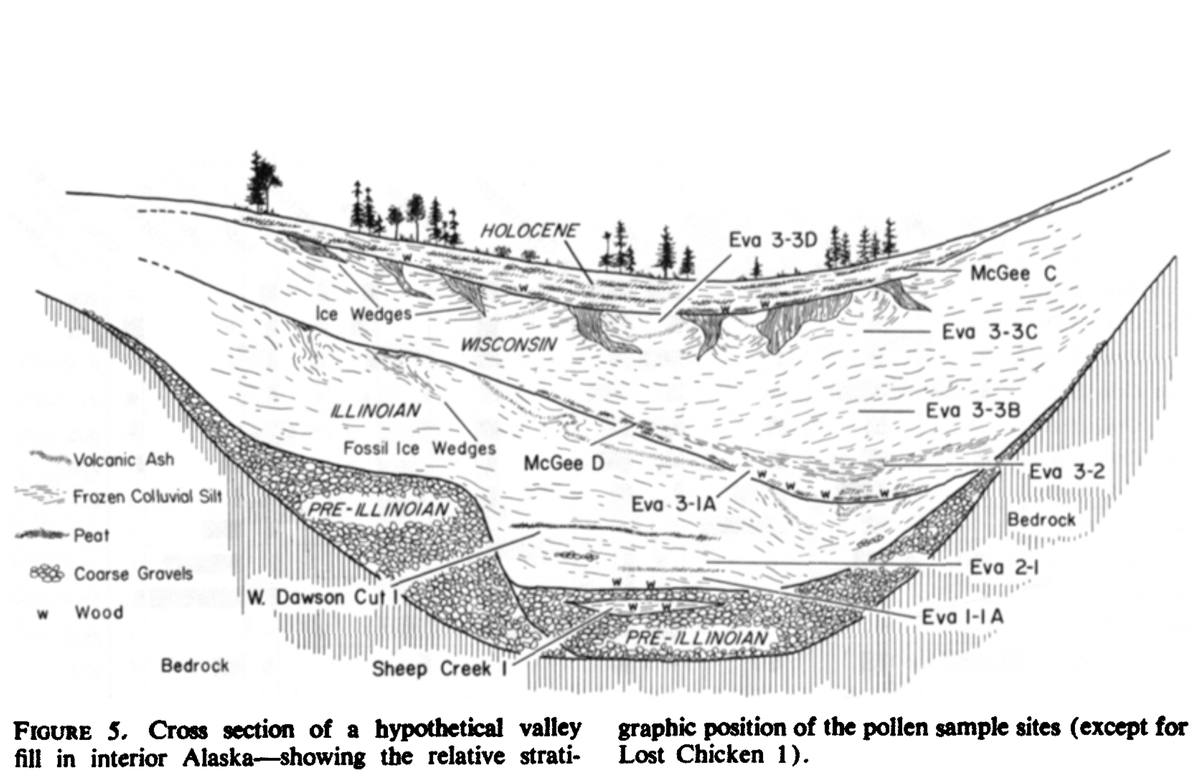Sad to hear of the passing of John V Matthews, formerly of Geological Survey of Canada. He was a pioneering Arctic paleoecologist and link to an earlier generation of Alaska/Arctic researchers – including David Hopkins, Troy Péwé, Jack Wolfe and John Fyles. John was 82. A thread.
John passed at home in Nova Scotia following a major stroke a few days ago. A thread on some of his science. These last few days as emails about his condition have worsened, many nice thoughts about his generosity, humour, and especially kindness have entered the discussion.
John was a noted Berigianist, having developed key ideas of the functional ecology of Beringia and the Mammoth Steppe— the graminoid ecosystem extending from NW Canada through Siberia that supported the grazing megafauna during cold stages of the Pleistocene.
He was also, with David Hopkins, one of the first to make strong connections to Russian Beringian science incl. Andrei Sher, Boris Yurtsev and Daniil Berman
There were two main threads of John’s research (or my thinking on John’s legacy)—his contribs to the steppe-tundra debate through the 1970s-1980s with Dale Guthrie, Charlie Schweger and David Hopkins; and his late Miocene/Pliocene/E Pleistocene work on origins of Arctic tundra.
John did his MSc at UAF with Dale Guthrie on the paleoecology of the Fairbanks area (Matthews 1970, AAR, 2, 241-251); the first pollen analysis to reconstruct ice age conditions of interior Alaska from ‘muck’ or could be called yedoma today. I think Dale’s first graduate student.
John started his work with pollen in the interior of Alaska, then developed analysis of plant macrofossils and fossil insects, in particular fossil ground beetles during his PhD work with noted entomologist George Ball and John Westgate (Geology) at the University of Alberta.
His interior AK work established some of the first pollen evidence of dry graminoid environments with substantial artemisia, past interglacials and the development of shrubs near the Pleistocene-Holocene transition. Chronology was poor in those days and confounding.
Many of those ideas about the mammoth-steppe conflicted with noted paleoecologists—Paul Colinvaux, Jim Ritchie and Richard West, but drove 25 years of debate on the nature of full-glacial Beringia—the ‘steppe-tundra’ debate.
Notably the idea that the pollen evidence from lake cores showed a poorly productive fell-field tundra that would have been unable to support mammoths, horses, bison and the guild of the mammoth steppe.
John is noted amongst the Beringianists as one of the original group (with Charlie Schweger, David Hopkins and Steve Young) behind the Paleoecology of Beringia (1982) which focused the steppe-tundra debate. Though in reality it became more entrenched. https://www.amazon.ca/Paleoecology-Beringia-David-M-Hopkins/dp/1483240711
The debate is well-described in Dale Guthrie's 'Frozen fauna of the mammoth steppe'. Which describes the functional ecology of the mammoth steppe and takes on the paleobotanical evidence and its interpretation. John's contributions figures prominently. https://press.uchicago.edu/ucp/books/book/chicago/F/bo3774765.html
John's PhD work, with George Ball (ground beetles) and John Westgate (Geology) focused on the origins of tundra ecosystems during the Quaternary. I found his PhD online last night. He worked at Cape Deceit on the Seward Penninsula.
https://era.library.ualberta.ca/items/d1eccb3a-43ff-4226-a435-0f88c3eb9bf8/view/9ca0800d-0534-4fd9-a193-77eaa708e06b/NK15285.pdf
https://era.library.ualberta.ca/items/d1eccb3a-43ff-4226-a435-0f88c3eb9bf8/view/9ca0800d-0534-4fd9-a193-77eaa708e06b/NK15285.pdf
In Canada, John spent many years working in the Old Crow basin in N. Yukon, and especially the Cdn Arctic on Beaufort and Ballast Brook Fm's- Late Miocene and Pliocene deposits that record the pre-glacial (~5-3Ma) forested Arctic. He was a specialist on plant macros and insects.
His 1990s paper, with Lynn Ovenden, on the pre-glacial Arctic floras is one of his most important in which he synthesizes the paleobotanical evidence for a forested Arctic and its relations to flora across Arctic North America, Greenland and Asia.
https://journalhosting.ucalgary.ca/index.php/arctic/article/view/64685
https://journalhosting.ucalgary.ca/index.php/arctic/article/view/64685
John maintained close relationships with those he worked with and was a champion and supporter of ECRs, especially female scientistis-- Alice Telka, Lynn Ovenden, Julie BG and Tamara Fletcher come to mind.
John maintained close relationships with those he worked with and was a champion and supporter of ECRs, especially female scientistis-- Alice Telka, Lynn Ovenden, Julie BG and Tamara Fletcher come to mind.

 Read on Twitter
Read on Twitter


